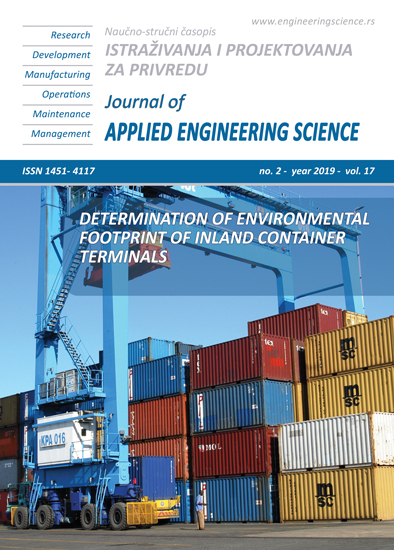THE SUBSTANTIATION OF ARCHITECTURAL-PLANNING TRANSFORMATIONS OF URBAN PUBLIC SPACES WITH THE ACCOUNT OF THE PRINCIPLES OF BIOPOSITIVITY
Abstract
This article presents the results of a scientific study conducted within the framework of an intra-university grant. The work was partially supported by the V.I. Vernadsky Crimean Federal University Development Program for 2015-2024. The analysis of the world experience in the design of biopositive public spaces in various cities of the world is considered, the methods for the formation of a sustainable biopositive urban space are outlined in the theoretical works of leading specialists in various directions. Spaces of Crimean cities, in particular its capital - Simferopol, listed a number of problems of the following public urban spaces : areas, landscape objects, pedestrian streets, embankment, etc., formed as a result of the development and growth of the modern city, the results of surveys conducted by the authors (questionnaires, social questions) among guests and local population of Crimean cities. wishes of the residents of Simferopol city, Alushta city and Chernomorskoye settlement to architectural-planning, composition-landscape and artistic expressive qualities of urban public spaces. A short characteristic of the most popular urban spaces is given, their advantages and disadvantages are indicated. The requirements of residents and guests of these the Crimean cities to the qualitative and quantitative characteristics of the material and technical and vegetable content of the urban environment are analyzed. Practical recommendations on the architectural and planning reconstruction of transport and pedestrian units, squares, garden and park facilities, embankments and courtyard spaces, taking into account the principles of biopositivity, are given. Experimental design models are proposed that consider the idea of transforming the existing public spaces of Crimean cities, taking into account modern international standards and information of sociological surveys
References
1. Lagodina E.V. The present and future of Russian public spaces [Nastoyashchee i budushchee rossijskih obshchestvennyh prostranstv]. Russian psychological journal, 2013, Tom 10, no. 4, рр. 62-69. Available at: https://cyberleninka.ru/article/n/nastoyaschee-i-buduschee-rossiyskih-obschestvennyh-prostranstv
2. Zhelnina A. "Here as a museum": a shopping center as a public space [«Zdes' kak muzej»: torgovyj centr kak obshchestvennoe prostranstvo]. Laboratorium, 2011, no. 2, рр. 48-69.
3. Shpakovskaya L.L, Chernova Zh.V. A city friendly to the family: a new public space for children and their parents [Gorod, druzhestvennyj sem'e: novoe publichnoe prostranstvo dlya detej i ih roditelej]. Monitoring of public opinion: Economic and social changes, 2017, no. 2, рр. 160-177.
4. Danilova T. Competition for the Elements of the City Environment for Irkutsk's Public Spaces: Street Furniture, Street Design. Project Baikal. Architecture, City and Environment, 2015, no. 12 (46), рр. 20-21.
5. Sidorova V., Chubova O. A Comprehensive Approach to the Reconstruction of Open Areas within the Curtilages of Multi-Storey Residential Buildings Built in 1970-1990-th. Architecture and Modern Information Technologies, 2017, no. 3(40), pp. 200-214. Available at: http://marhi.ru/eng/AMIT/2017/3kvart17/15_sidorova-chubova/index.php
6. Zukin Sharon. The cultures of cities. - Oxford: Blackwell, 2000. - 338 р.], Michael Sorkin [Michael Sorkin, Sharon Zukin. After the World Trade Center: Rethinking New York City. - Routledge: New York, 2013. - 240 p.
7. Historical context of interventions in the landscape and in urban spaces [Text] / Letícia Peret Antunes Hardt, Carlos Hardt // Paisagem e Ambiente. 2007;0(23):101-107 р
8. Joana Carla Soares Gonçalves. Environment, energy and sustainable design: buildings and urban spaces [Text] / Joana Carla Soares Gonçalves // Pós: Revista do Programa de Pós-Graduação em Arquitetura e Urbanismo da FAUUSP. 2007; 0(21):232-237 p.
9. Adriano Magliocco. Urban environment and vegetation: comfort and urban heat island mitigation [Text] / Adriano Magliocco, Katia Perini // Techne : Journal of Technology for Architecture and Environment. 2014; 0(8):155-162p.
10. Tetior A.N. Architectural and construction ecology [Arhitekturno-stroitel'naya ehkologiya]. Moscow: Academy, 2008, 368 p.
11. Esaulov, G.V. Sustainable architecture - from principles to development strategy [Ustojchivaya arhitektura – ot principov k strategii razvitiya]. Vestnik of TSUAB, No. 6, 2014, pp. 9-24.
12. Jan Gehl. Cities for People [Goroda dlya lyudej]. Ed. in Russian. Concern "KROST", per. with English. Moscow: Alpina Pablisher, 2012, 276 p.
13. Lee Kuan Y. Singapore's history. From the "third world" - to the "first" [Singapurskaya istoriya. Iz "tret'ego mira" – v "pervyj"]. Moscow: MGIMO (U) MFA of Russia, 2005, 576 p.
14. Henri Lefèvre, Production of space [Proizvodstvo prostranstva]. Moscow, 2015, 432 p.
15. Colin Ellard. Places of the Heart: The Psychogeography of Everyday Life [Sreda obitaniya: Kak architektura vliyaet na nashe povedenie i samochu-vstvie], Moscow, Alpina Pablisher, 2017, 2nd ed., 288 p.
16. Quality of Living City Ranking (Рейтинг качества жизни городов). [Электронный ресурс]: – Режим доступа: https://mobilityexchange.mercer.com/Insights/quality-of-living-rankings
17. Urban projects of I.Varlamov and M.Katz. Six examples of good public spaces. Available at: https://city4people.ru/post/blog_583.html (accessed 9 September 2018).
18. The Crimea. Reality. How to build the oldest park in Simferopol "Salgirka" (photo gallery) Available at: https://ru.krymr.com/a/photo/28793639.html (accessed 9 September 2018).
19. Cities of Russia. City of Simferopol Available at: http://города-россия.рф/sity_id.php?id=85 (accessed 9 September 2018).
20. Strategy of social and economic development of the municipal formation of the city of Simferopol until 2030. Available at: https://evp.rk.gov.ru/ru/structure/465 (accessed 9 September 2018).
21. Active Simferopol. Voting: "Public spaces and urban environment" Available at: http: //xn--80aejkbfenhhpammll5bzi4a.xn--p1ai/poll/508 (accessed 9 September 2018).
22. Sidorov V. V., Mosyakin S. D. On the necessity of forming a network structure of a multifunctional youth centres. [O neobhodimosti formirovaniya struktury seti mnogofunkcional'nyh molodezhnyh centrov.] Bulletin of the South Ural State University. Series "Construction and architecture." Urbanism and architecture. 2017, Тom. 17, no. 4, рр. 5-14
23. Sidorova V.V. Sociological research on coastal areas [Sociologicheskie issledovaniya po pribrezhnym territoriyam]. Modern problems of architecture and urban planning: Nauch.-Tekhn. compilation. Kyiv: KNUCA, 2011, no. 28 рр. 267-275
24. Survio. Соц.опрос: «Общественные пространства в г. Симферооль». [Электронный ресурс]: – Режим доступа: https://www.survio.com/survey/d/C4T2T4H6S7F4T4R3P

